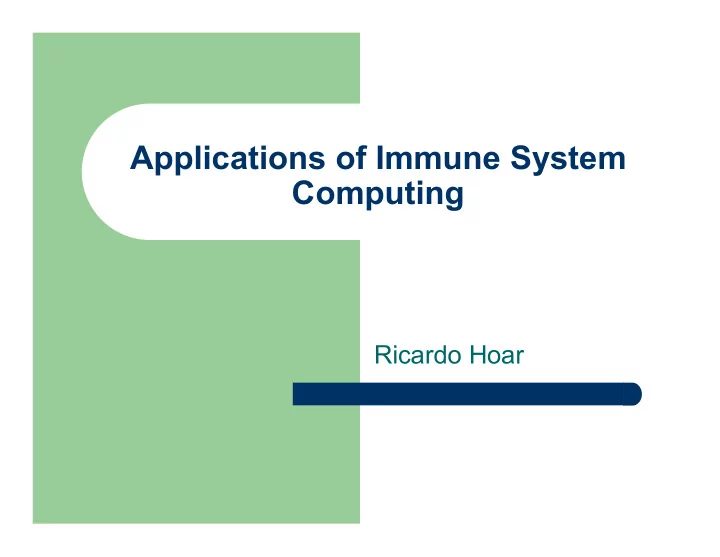

Applications of Immune System Computing Ricardo Hoar
What kind of applications? l Computer Security l Pattern Recognition l Data Mining and Retrieval l Multi-Agent Systems l Design Optimization l Control Applications l Robotics l …
A Distributed Architecture for a Self Adaptive Computer Virus Immune System Gary B. Lamont, Robert E. Marmelstein, and David A. Van Veldhuizen l Simplified Biological IS Model (BIS) l Relationships between BIS and CVIS l CVIS model l Discussion of some algorithms involved in CVIS
Simplified Biological IS Model l Extracellular BIS – High level set of interacting components: l Generator/Repressor – B-cells, antibodies l Detector – Detect antigen , detect host/non host l Classifier – Once antigen detected, B-cell determines type l Purger – Eg. Macrophage , antigen purging or cleansing l BIS memory – A store of successful B-cell threat responses l Adaptation process – Continual updating in reaction to imperfect coverage of all pathogens
Extracellular BIS (Diagram)
Intracellular BIS l Attempts to find antigens within living human cells. l Generate “Helper” T Cells which can promote antibody prodection from B cells l Antigen Presentation l Major Histocompatability Complex (recognition by T cells)
Intracellular BIS (Diagram)
Computer Virus l Significant Computer Threat l High “birth rate” of new viruses l Inability of Anti-Virus software to detect the newest Viruses.
Current Methods for Virus Scanning l Current Virus scanning Software looks for bit patterns known to belong to a specific virus. Additionally deductive techniques use “rules of thumb” to identify programs that exhibit “virus like” behaviors. l Although reliable , these methods rely on static knowledge bases, resulting in a the need for continual updating.
More robust method needed l Why not apply the principals from immune computing to this obvious application of scanning for Viruses? l Which components of BIS can be used to define a Computer Virus Immune System ? l What are the main implementation challenges?
Computer Virus Immune System l Components – Genereate/Suppress Virus l Generate random signatures, Compare signatures to prior sig. – Classify Virus l Isolate virus based on its characteristics, signature extraction – Purge Virus l Purge the virus and repair damaged system resources – Augment Virus Database l If new virus, add to memory l Main Challenge – Replicating BIS inherent parallelism
Generic CVIS Algorithm
Self/Non-Self Determination l Distinguishing legitimate computer resources from those corrupted by a computer virus l Accomplished via detectors generated at random and compared to protected data l Requires a significant number of detectors l Can become cumbersome if protecting changing files due to creation of new detectors
Self/Non-Self Determination Algorithm
Virus Decoy l Uses decoy programs whose sole purpose is to become infected l Infected decoy can automatically extract viral signature l Does not require the regeneration with changing files l Must be used in conjunction with another method to identify classified viruses
Virus Decoy Algorithm
Immunity by Design: An Artificial Immune System Steven A. Hofmeyr and Stephanie Forrest
ARCHITECTURE l To preserve generality, we represent both the protected system (self) and infectious agents (nonself) as dynamically changing sets of bit strings. l In cells of the body the profile of expressed proteins (self) changes over time, and likewise, we expect our set of protected strings to vary over time. l The body is subjected to different kinds of infections over time; we can view nonself as a dynamically changing set of strings.
EXAMPLE: NETWORK SECURITY l We define self to be the set of normal pair wise connections (at the TCP/IP level) between computers. l A connection is defined in terms of its “data-path triple”—the source IP address, the destination IP address, and the service (or port) by which the computers communicate. (49 bit string) l Self signifies recognized familiar addresses while Non-self represents “foreign” addresses
NETWORK SECURITY l Each detector cell is represented by a 49 bit string. l Detection = String Matching l New detectors are randomly generated and eliminated if they are matched while still immature (removal of self) l Mature detectors can activate an alarm if a threshold is reached or be removed if they remain unmatched. l This balance between naïve immature and mature cells gives the system adequate adaptability to new antigens.
The Architecture of the AIS.
Lifecycle of a detector
EXPERIMENTAL RESULTS l Two data sets were collected: l The self set was collected over 50 days. l Self = 1.5 million datapaths mapped to 49-bit binary strings. l At time 0 in the simulation a synthetic attack was detected with probability p = 0.23. l After letting the system respond and adapt for 3 months attack detected with probability 0.76, demonstrating the effectiveness of AIS for learning
Combinatorial Optimization (n-TSP Problem)
Combinatorial Optimization (n-TSP Problem) l Endo et al . (1998) and Toma et al. (1999) proposed an adaptive optimization algorithm based on the immune network model and MHC peptide presentation . In this model, immune network principles were used to produce adaptive behaviors of agents and MHC was used to induce competitive behaviors among agents. The agents possessed a sensor, mimicking MHC peptide presentation by macrophages, the T-cells were used to control the behavior of agents and the B-cells were used to produce behaviors.
Problem Comparison
Refrences de Castro, L, Zuben, F. ARTIFICIAL IMMUNE SYSTEMS: PART II – A l SURVEY OF APPLICATIONS Technical Report DCA-RT 02/00 accessed from: http://www.cs.plu.edu/pub/faculty/spillman/seniorprojarts/ids/part2.pdf Hofmeyr, S., Forrest S. Immunity by Design: An Artificial Immune System l Lamont, G., Marmelstein R., Veldhuizen D. A Distributed Architecture for l a Self Adaptive Computer Virus Immune System New Ideas in Optimization Dasgupta, D. Artificial Immune systems: Theory and Applications Tutorial l WCCI 2002, Honolulu Hawaii.
Recommend
More recommend